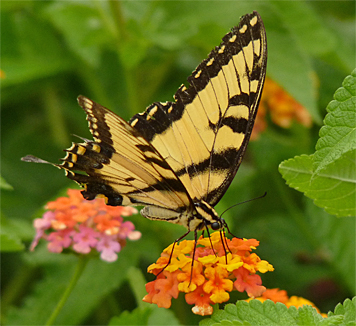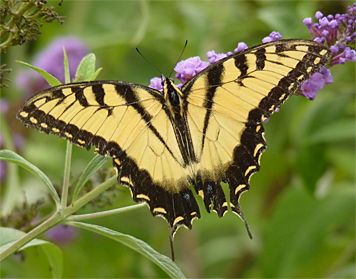It has been widely reported over the last week or so that Eastern Tiger Swallowtails are being seen in large numbers throughout our area (the Carolinas). Listservs such as Carolina Leps have had posts which speak of “an explosion of Tiger Swallowtails” and subject lines like “Tigers!” and “Day of the Tiger.” It’s no different here at the Museum. Tiger swallowtails are back!
Tiger swallowtail numbers peak in April/May and again in late July/August here in the Piedmont, although they can be seen in lesser numbers anytime from March thru October.
We happen to be in the second peak period and these large yellow and black butterflies can be seen throughout the outdoor areas. The best place to look for them though, is in the garden along the walkway and stairs at the entrance to the Butterfly House, especially on the lantana and butterfly bush.


The tiger pictured above is a male. Females have more blue in the hindwing. And, surprise, a certain percentage of the females are dark.

It may also come as a surprise to you that the farther north you travel the fewer dark morph females you’re likely to encounter. In other words, the percentage of dark females per the total population of females is more in North Carolina than it is in New York. Why?
The dark morph of the female Eastern Tiger Swallowtail is supposedly a mimic of another large black butterfly, the Pipevine Swallowtail. Pipevines are said to be distasteful to predators, such as birds, because of the chemical makeup of their host plant, the plant that the caterpillars feed on, which is pipevine (much like the relationship between Monarch Butterflies and milkweed). Pipevine Swallowtails are less common the farther north you travel, so, as the theory goes, there are fewer dark morph female Tiger Swallowtails as well.
That all sounds good, but it does nothing to explain why only the females have a dark morph. There’s no disputing that there are fewer dark female E. Tiger Swallowtails and fewer Pipevine Swallowtails up north. Those are facts that I can personally attest to. And, it seems reasonable to assume that a percentage of dark female tigers and the number of Pipevines present in a population could be somehow related. But why are only some of the females dark and why do none of the males show the same variation, that is, a dark morph? Could this be evolution in progress, or is it simply coincidence?
While you ponder the tigers and the reasons for their color morphs, keep an eye out for these other nectar lovers on the flowers of the garden outside the Butterfly House.



And while your in the neighborhood, look for these two bugs on the Butterfly Weed (Asclepias tuberosa).


The milkweed bugs above were actually on a Butterfly Weed in Catch the Wind (next to the Ornithopter), but any Butterfly Weed will do at this time of year.
Look for both of the milkweed bugs on the seed pods. They may be present elsewhere on the plant but they lay eggs on the pods, and eat the seeds.
- Richard Stickney of the Butterfly House has an image that shows the tiger-stripe pattern of the dark morph Eastern Tiger Swallowtail a bit more clearly.
Check out this cool bilateral gyandromorph Tiger Swallowtail found in Hillsborough. Half male-half female!
http://www.flickr.com/photos/rstickney/4867405545/
I saw that, and yes, it is very cool!
Google gynandromorph and click on “images” at the top left of the browser and you’ll see a bunch of other gynandromorphs, birds, beetles, crabs…I think you’ll especially be interested in the Rose-breasted Grosbeak and Northern Cardinal.